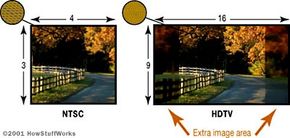TV Goes Digital
The term "digital TV" is used in many different ways right now, depending on whom you're talking to. There's also the term "HDTV," which is the most advanced form of digital TV in use in the United States. The reason it gets confusing is because digital TV in the United States combines three different ideas.
The first idea that is new to digital TV is the digital signal.
Advertisement
Analog TV started as a broadcast medium. TV stations set up antennas and broadcast radio signals to individual communities. You can attach an antenna to your TV and pick up channels 2 through 83 for free. What you receive, as described earlier, is a single, analog composite video signal and a separate sound signal.
Digital TV started as a free broadcast medium as well. For example, in San Jose, Calif., you can tune in to about a dozen different commercial digital TV stations if you have a digital TV receiver and an antenna. The FCC gave television broadcasters a new frequency to use for their digital broadcasts, so until the digital transition is complete, each broadcaster has an analog TV channel and a digital TV channel. The digital channel carries a 19.39-megabit-per-second stream of digital data that your digital TV receives and decodes.
Each broadcaster has one digital TV channel, but one channel can carry multiple sub-channels if the broadcaster chooses that option. Here's how it works:
On its digital channel, each broadcaster sends a 19.39-megabit-per-second (Mbps) stream of digital data. Broadcasters have the ability to use this stream in several different ways. For example:
- A broadcaster can send a single program at 19.39 Mbps.
- A broadcaster can divide the channel into several different streams (perhaps four streams of 4.85 Mbps each). These streams are called sub-channels, and this type of broadcasting is called multicasting. For example, if the digital TV channel is channel 53, then 53.1, 53.2 and 53.3 could be three sub-channels on that channel. Each sub-channel can carry a different program.
The reason that broadcasters can create sub-channels is because digital TV standards allow several different formats. Broadcasters can choose between three formats:
- 480i - The picture is 704x480 pixels, sent at 60 interlaced frames per second (30 complete frames per second).
- 480p - The picture is 704x480 pixels, sent at 60 complete frames per second.
- 720p - The picture is 1280x720 pixels, sent at 60 complete frames per second.
- 1080i - The picture is 1920x1080 pixels, sent at 60 interlaced frames per second (30 complete frames per second).
- 1080p - The picture is 1920x1080 pixels, sent at 60 complete frames per second.
(The "p" and "i" designations stand for "progressive" and "interlaced." In a progressive format, the full picture updates every 60th of a second. In an interlaced format, half of the picture updates every 60th of a second.)
The 480p and 480i formats are called the SD (standard definition) formats, and 480i is roughly equivalent to a normal analog TV picture. When analog TV shows are upconverted and broadcast on digital TV stations, they're broadcast in 480p or 480i.
The 720p, 1080i and 1080p formats are HD (high definition) formats. When you hear about "HDTV," this is what is being discussed -- a digital signal in the 720p, 1080i or 1080p format.
Finally, the HD formats of digital TV have a different aspect ratio than analog TVs. An analog TV has a 4:3 aspect ratio, meaning that the screen is 4 units wide and 3 units high. For example, a "25-inch diagonal" analog TV is 15 inches high and 20 inches wide. The HD format for digital TV has a 16:9 aspect ratio, as shown below:
The type of signal, format and aspect ratio have all changed in the process of converting from analog TV to digital TV in the United States.
